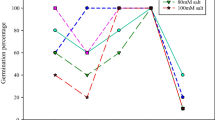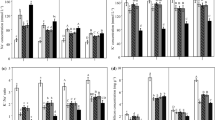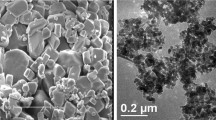Abstract
This study aimed at exploration of nickel (Ni) application (0, 10, 20, 30, and 40 mg L−1) on physiological and biochemical attributes of sunflower cultivars (Hysun-33 and SF-187) grown in sand culture. Results revealed a significant decrease in vegetative parameters in both sunflower cultivars by increasing Ni concentration, although low levels of Ni (10 mg L−1) improved growth attributes to some extent. Among photosynthetic attributes, 30 and 40 mg L−1 Ni application severely reduced the photosynthetic rate (A), stomatal conductance (gs), water use efficiency (WUE), and Ci/Ca ratio but improved the transpiration rate (E) in both sunflower cultivars. The same level of Ni application also reduced leaf water potential, osmotic potentials, and relative water contents but increased leaf turgor potential and membrane permeability. At low level (10 and 20 mg L−1), Ni improved the soluble proteins, while high Ni concentration decreased it. The opposite was true for total free amino acids and soluble sugars. To conclude, the high Ni concentration in various plant organs had a strong impact with the changes in vegetative growth, physiological and biochemical attributes. A positive correlation of growth, physiological, water relations, and gas exchange parameters at low levels of Ni and negative correlation at higher Ni level confirmed that the supplementation of low Ni levels greatly modulated studied attributes. Based on observed attributes, Hysun-33 showed high tolerance to Ni stress as compared to SF-187.










Similar content being viewed by others
Data availability
The raw data can be taken from the author on request.
References
Ahmad MSA, Ashraf M (2011) Essential roles and hazardous effects of nickel in plants. Rev Environ Contam Toxicol 214:125–167. https://doi.org/10.1007/978-1-4614-0668-6_6
Ahmad MSA, Hussain M, Ashraf M, Ahmad R, Ashraf MY (2009) Effect of nickel on seed germinability of some elite sunflower (Helianthus annuus L.) cultivars. Pak J Bot 41:1871–1882
Ahmad M, Iqbal J, Kaleem S, Wasaya A, Ishaque M (2011) Qualitative analysis of spring planted sunflower hybrids as influenced by varying nutritional area. Pak J Nutr 10:291–295. https://doi.org/10.3923/PJN.2011.291.295
Ahmad MSA (2011) Influence of nickel stress on growth, morpho-physiological and anatomical attributes of sunflower (Helianthus annuus L.). PhD Dissertation, Submitted to University of Agriculture, Faisalabad. http://prr.hec.gov.pk/jspui/handle/123456789/1866
Ali MA, Ashraf M, Athar HR (2009) Influence of nickel stress on growth and some important physiological/biochemical attributes in some diverse canola (Brassica napus L.) cultivars. J Hazard Mater 172:964–969. https://doi.org/10.1016/j.jhazmat.2009.07.077
Amari T, Ghnaya T, Debez A, Taamali M, Lucchini YNB, G, Sacchi GA, Abdelly C, (2014) Comparative Ni tolerance and accumulation potentials between Mesembryanthemum crystallinum (halophyte) and Brassica juncea: metal accumulation, nutrient status and photosynthetic activity. J Plant Physiol 171:1634–1644. https://doi.org/10.1016/j.jplph.2014.06.020
Arnon DI (1949) Copper enzymes in isolated chloroplasts Polyphenoloxidase in Beta Vulgaris. Plant Physiol 24:1–15. https://doi.org/10.1104/pp.24.1.1
Ashraf MY, Sadiq R, Hussain M, Ashraf M, Ahmad MSA (2011) Toxic effect of nickel (Ni) on growth and metabolism in germinating seeds of sunflower (Helianthus annuus L.). Biol Trace Elem Res 143:1695–1703. https://doi.org/10.1007/s12011-011-8955-7
Bai C, Reilly CC, Wood BW (2006) Nickel deficiency disrupts metabolism of ureides, amino acids, and organic acids of young pecan foliage. Plant Physiol 140:433–443. https://doi.org/10.1104/pp.105.072983
Batool S (2018) Effect of nickel toxicity on growth, photosynthetic pigments and dry matter yield of Cicer arietinum L. varieties. Asian J Agric Biol 6:143–148
Boominathan R, Doran PM (2002) Ni-induced oxidative stress in roots of the Ni hyperaccumulator, Alyssum bertolonii. New Phytol 156:205–215
Boyer J (1967) Leaf water potentials measured with a pressure chamber. Plant Physiol 42(1):133–7. https://doi.org/10.1104/pp.42.1.133
Chris A (2012) Effect of nickel stress on growth and antioxidants in cyanobacterium Cylindrospermum sp. Asian J Biol Sci 7:13–17
D’Antò V, Valletta R, Amato M, Schweikl H, Simeone M, Paduano S, Rengo S, Spagnuolo G (2012) Effect of nickel chloride on cell proliferation. Open Dent J 6:177–181. https://doi.org/10.2174/1874210601206010177
Davis BH (1976) Carotenoids. In: Goodwin TW (ed) Chemistry and biochemistry of plant pigments. Academic Press Inc., London, pp 38–165
Demchenko NP, Kalimova IB, Demchenko KN (2010) Effect of nickel at high concentration on proliferation of quiescent center cells and initiation of lateral root primordia in wheat seedlings. Russian J Plant Physiol 57:438–447. https://doi.org/10.1134/S1021443710030179
Duman F, Ozturk F (2010) Nickel accumulation and its effect on biomass, protein content and antioxidative enzymes in roots and leaves of watercress (Nasturtium officinale R. Br.). J Environ Sci 4:526–532. https://doi.org/10.1016/s1001-0742(09)60137-6
Fabiano CC, Tezotto T, Favarin JL, Polacco JC, Mazzafera P (2015) Essentiality of nickel in plants: a role in plant stresses. Front Plant Sci 6:754. https://doi.org/10.3389/fpls.2015.00754
Freitas DS, Rodak BW, dos Reis AR, Reis FDB, Carvalho TSD, Schulze J, Carneiro MAC, Guilherme LRG (2018) Hidden nickel deficiency? nickel fertilization via soil improves nitrogen metabolism and grain yield in soybean genotypes. Front Plant Sci 9:614. https://doi.org/10.3389/fpls.2018.00614
Gajewska E, Skłodowska M (2007) Effect of nickel on ROS content and antioxidative enzyme activities in wheat leaves. Biometals 20:27–36. https://doi.org/10.1007/s10534-006-9011-5
González-Guerrero M, Matthiadis A, Sáez Á, Long TA (2014) Fixating on metals: new insights into the role of metals in nodulation and symbiotic nitrogen fixation. Front Plant Sci 13:5–45. https://doi.org/10.3389/fpls.2014.00045
Gupta V, Jatav PK, Verma R, Kothari SL, Kachhwaha S (2017) Nickel accumulation and its effect on growth, physiological and biochemical parameters in millets and oats. Environ Sci Pollut Res Int 24:23915–23925. https://doi.org/10.1007/s11356-017-0057-4
Hamilton PB, Van-Slyke DD (1943) Amino-acid determination with ninhydrine. J Biol Chem 150:231–233
Hassan MU, Chattha MU, Khan I, Chattha MB, Aamer M et al (2019) Nickel toxicity in plants: reasons, toxic effects, tolerance mechanisms, and remediation possibilities-a review. Environ Sci Pollut Res Int 26:12673–12688. https://doi.org/10.1007/s11356-019-04892-x
Hedfi A, Mahmoudi E, Boufahja F, Beyrem H, Aissa P (2007) Effects of increasing levels of nickel contamination on structure of offshore nematode communities in experimental microcosms. Bullet Environ Contam Toxicol 79:345–349. https://doi.org/10.1007/s00128-007-9261-0
Hussain S, Farooq M, Wahid MA, Wahid A (2013) Seed priming with putrescine improves the drought resistance of maize hybrids. Int J Agric Biol 15:1349–1353. https://doi.org/10.1016/j.plgene.2017.04.004
Jagetiya B, Soni A, Yadav S (2013) Effect of nickel on plant water relations and growth in green gram. Indian J Plant Physiol 18:372–376. https://doi.org/10.1007/s40502-013-0053-8
Jha AB, Dubey RS (2005) Effect of arsenic on behaviour of enzymes of sugar metabolism in germinating rice seeds. Acta Physiol Plant 27:341–347. https://doi.org/10.1007/s11738-005-0010-x
Jogawat A (2019) Osmolytes and their role in abiotic stress tolerance in plants. In: Roychoudhury A, Tripathi D (eds) Molecular plant abiotic stress: biology and biotechnology. Wiley, pp 91–104
Kachenko A, Bhatia N, Singh B (2011) Influence of drought stress on the nickel-hyperaccumulating shrub Hybanthus floribundus (Lindl.) F. Muell. subsp. floribundus. Int J Plant Sci 172:315–322. https://doi.org/10.1086/658154
Khaliq A, Ali S, Hameed A, Farooq MA, Farid M, Shakoor MB, Mahmood K, Ishaque W, Rizwan M (2016) Silicon alleviates nickel toxicity in cotton seedlings through enhancing growth, photosynthesis, and suppressing Ni uptake and oxidative stress. Arch Agron Soil Sci 62:633–647. https://doi.org/10.1080/03650340.2015.1073263
Koźmińska A, Wiszniewska A, Hanus-Fajerska E, Muszyńska E (2018) Recent strategies of increasing metal tolerance and phytoremediation potential using genetic transformation of plants. Plant Biotechnolo Rep 12:1–4. https://doi.org/10.1007/s11816-017-0467-2
Kumar S, Trivedi AV (2016) A review on role of nickel in the biological system. Int J Curr Microbiol Appl Sci 5:719–727. https://doi.org/10.20546/ijcmas.2016.503.084
Llamas A, Ullrich CI, Sanz A (2008) Ni2+ toxicity in rice: effect on membrane functionality and plant water content. Plant Physiol Biochem 46:905–910. https://doi.org/10.1016/j.plaphy.2008.05.006
Lowry OH, Rosebrough NJ, Farr AL, Randal RJ (1951) Protein measurement with folin phenol reagent. J Biol Chem 193:265–275
Moghaddam SR (2018) Phytoremediation ability of nickel-contaminated soil using Sunflower (Helianthus annuus L.) and Sorghum (Sorghum bicolor L.). J Soil Manag Sus Prod 6:131–142. https://doi.org/10.22069/ejsms.2017.10042.1593
Nie J, PanY SJ, Guo Y, Yan Z, Duan X, Xu M (2015) A comparative study on the uptake and toxicity of nickel added in the form of different salts to maize seedlings. Int J Environ Res Public Health 12:15075–15087. https://doi.org/10.3390/ijerph121214972
Patra A, Dutta A, Mohapatra KK, Pradhan S (2020) Nickel the ultra-micronutrient: significant for plant growth and metabolism. Food Chem Toxicol 1:35–37
Riazi A, Matruda K, Arslan A (1985) Water stress induced changes in concentration of proline and other solutes in the growing regions of plant. J Exp Bot 36:1716–1725. https://doi.org/10.1093/jxb/36.11.1716
Rosa M, Prado C, Podazza G, Interdonato R, González JA, Hilal M, Prado FE (2009) Soluble sugars–metabolism, sensing and abiotic stress: a complex network in the life of plants. Plant Signal Behav 4:388–393. https://doi.org/10.4161/psb.4.5.8294
Rucińska-Sobkowiak R (2016) Water relations in plants subjected to heavy metal stresses. Acta Physiol Plant 38:257. https://doi.org/10.1007/s11738-016-2277-5
Rucińska-Sobkowiak R, Nowaczyk G, Krzesłowska M, Rabęda I, Jurga S (2013) Water status and water diffusion transport in lupine roots exposed to lead. Environ Exp Bot 87:100–109. https://doi.org/10.1016/j.envexpbot.2012.09.012
Shahzad B, Tanveer M, Rehman A, Cheema SA, Fahad S, Rehman S, Sharma A (2018) Nickel; whether toxic or essential for plants and environment - a review. Plant Physiol Biochem 132:641–651. https://doi.org/10.1016/j.plaphy.2018.10.014
Shanying H, Zhenli H, Yang X, Virupax C, Baligar (2012) Mechanisms of nickel uptake and hyperaccumulation by plants and implications for soil remediation. In: Donald L, Sparks (ed) Advances in Agronomy. Academic Press, Volume 117, pp117–189
Singh K, Pandey SN (2011) Effect of nickel-stresses on uptake, pigments and antioxidative responses of water lettuce, Pistia stratiotes L. J Environ Biol 32:391–394
Steel RGD, Torrie JH, Dickey DA (1996) Principles 3rd and procedures of statistics: a biometrical approach, (Eds) McGraw Hill Co., New York, USA
Stoikou V, Andrianos V, Stasinos S, Kostakis MG, Attiti S, Thomaidis NS, Zabetakis I (2017) Metal uptake by sunflower (Helianthus annuus) irrigated with water polluted with chromium and nickel. Food 6:51. https://doi.org/10.3390/foods6070051
Szymaska M, Matraszek R (2005) Reaction of the sunflower (Helianthus annuus L.) to nickel conditioned by the way of metal penetration. Acta Sci Pol Hortorum Cultus 4:139–152
Velikova V, Tsonev T, Loreto F, Centritto M (2011) Changes in photosynthesis, mesophyll conductance to CO2, and isoprenoid emissions in Populus nigra plants exposed to excess nickel. Environ Pollut 159:1058–1066. https://doi.org/10.1016/j.envpol.2010.10.032
Vernay P, Gauthier-Moussard C, Hitmi A (2007) Interaction of bioaccumulation of heavy metal chromium with water relation, mineral nutrition and photosynthesis in developed leaves of Lolium perenne L. Chemosphere 68:1563–1575. https://doi.org/10.1016/j.chemosphere.2007.02.052
Wolf B (1982) A comprehensive system of leaf analysis and its use for diagnosing crop nutrient status. Commun Soil Sci Plant Anal 13:1035–1059. https://doi.org/10.1080/00103628209367332
Wood BW, Reilly CC, Nyczepir AP (2006) Field deficiency of nickel in trees: symptoms and causes. Acta Hort 721:83–98. https://doi.org/10.17660/ActaHortic.2006.721.10
Wood BW (2013) Iron-induced nickel deficiency in pecan. Hort Sci 48:1145–1153. https://doi.org/10.21273/HORTSCI.48.9.1145
Yang G, Joly RG, RJ (1996) Effects of high temperature on membrane stability and chlorophyll fluorescence in glycinebetaine-deficiency and glycinebetaine- containing maize lines. Aust J Plant Physiol 23:437–443. https://doi.org/10.1071/PP9960437
Younis U, Danish S, Malik SA, Ahmed N, Munir TM, Rasheed MK (2020) Role of cotton sticks biochar in immobilization of nickel under induced toxicity condition and growth indices of Trigonella corniculata L. Environ Sci Pollut Res Int 27:1752–1761. https://doi.org/10.1007/s11356-019-06466-3
Acknowledgements
This paper is a part of Ph.D. studies of Muhammad Sajid Aqeel Ahmad, Department of Botany, University of Agriculture, Faisaalabad.
Author information
Authors and Affiliations
Contributions
Muhammad Sajid Aqeel Ahmad has performed statistical analysis of this paper. Alia Riffat has edited, corrected, and proofread the manuscript. Mumtaz Hussain and Mansoor Hameed read and finalized the manuscript. Ambreen Khadija Alvi participated in manuscript editing and language correction.
Corresponding author
Ethics declarations
Ethical approval and consent to participate
The manuscript was submitted solely to Environmental Science and Pollution Research, and no part was published or submitted elsewhere. All ethical guidelines set by parent institution(s) were observed during sampling and analysis.
Consent to publication
All the authors completely agreed to publish the manuscript.
Competing interests
The authors declare no competing interests.
Additional information
Responsible Editor: Gangrong Shi
Publisher's note
Springer Nature remains neutral with regard to jurisdictional claims in published maps and institutional affiliations.
Supplementary Information
Below is the link to the electronic supplementary material.
Rights and permissions
Springer Nature or its licensor (e.g. a society or other partner) holds exclusive rights to this article under a publishing agreement with the author(s) or other rightsholder(s); author self-archiving of the accepted manuscript version of this article is solely governed by the terms of such publishing agreement and applicable law.
About this article
Cite this article
Ahmad, M.S.A., Riffat, A., Hussain, M. et al. Toxicity and tolerance of nickel in sunflower (Helianthus annuus L.). Environ Sci Pollut Res 30, 50346–50363 (2023). https://doi.org/10.1007/s11356-023-25705-2
Received:
Accepted:
Published:
Issue Date:
DOI: https://doi.org/10.1007/s11356-023-25705-2




